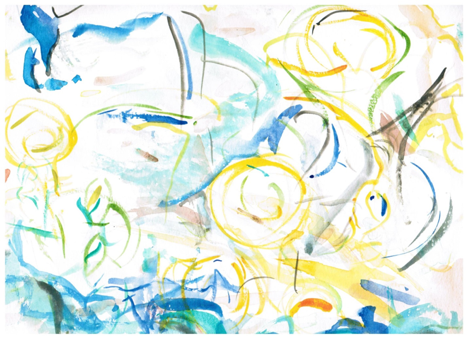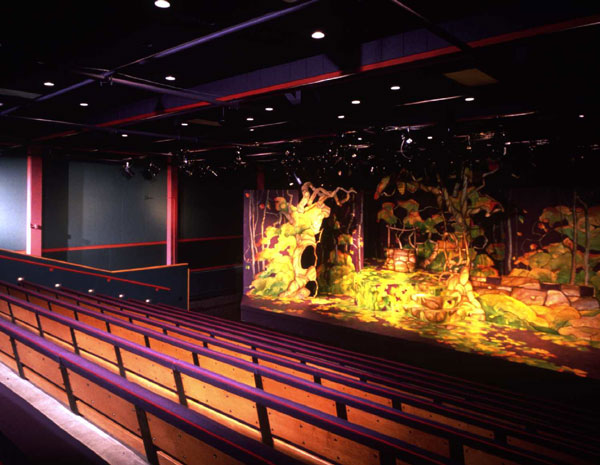
A few years ago I had a shoulder injury and I smoked a lot weed to dull the pain: it didn’t get me high or provide any relief, but it woke my senses and made me want to paint. My mother had been a painter, I loved watching her paint scenes from her Louisiana childhood. Unlike Mom’s work, my new watercolors have few landscape or people in them,. They are not “representational” — but you see a go-for-broke sunset once and it’s an occurrence; you see it through the years and it ends up haunting you. Recognizable shapes now appear in my work. The vacant lot behind our house interrupted by a neighbor’s dog traipsing through it; the live oak blown down in last September’s storm suddenly commands my view.
The colors in my watercolors have changed, too. I am partial to blue. In Vermont, I translated the blue-green of hemlocks and spruce, the midnight-blue of a mountain stream into washes of watercolor crosshatched by swatches of sonic blue. But blue isn’t dominant in Georgia. Think sedgy greens, hibiscus reds, burnt oranges with mucky browns smudged in. How to get to the soul of these colors, to make more of them than a mosaic of offhand impressions? My senses awake to new colors —and they recoil from them too. I’m a sucker for anything that activates “my blue” — a mouthful of turbid down-home south Georgia churchy blue. How to transcend well-worn cliches of the Deep South and its gothic trappings? I’ve read too much O’Connor and Faulkner, have seen too many “charming” local color paintings of coastal Georgia to get through to the hurt, bruised blue of the horizon.
**
I once thought all forms of landscape were biographical, and it’s still nice to think that’s true. There’s a soundtrack to my paintings, arpeggios of turbid waterfall blue saturating my paper or canvass. I used to put on music when I worked, but now the music backbeats inside my head. The live oaks down by the marsh behind my house show scars from a hurricane that blew through here a century ago; a rope swing hanging from one of those oaks tragically reminds me of a lynching that happened not long after that historic storm. Words can’t do these images of justice — photographs, and landscape painting won’t do it either.
A few blocks away from my house come the voices of the reborn, the saved. They sing about how they’ve survived through storms, lynchings and Jim Crow in tin roof shacks down on Cathead Creek, but if I painted folks living here, I wouldn’t do them justice, couldn’t bring their stories onto canvas or paper.
I pass the church and head down River Street toward the graveyard to do some watercolors. Through the canopy, I see Cathead Creek. Bees and dragonflies hum. Buzzards soar. A realist might depict the scene in muddy russets, gravestones fallen into knee-high grass haunted by regret and neglect. A realist would sketch in a tumbledown shack downhill overgrown with Confederate jasmine. But I am not a realist. I try to pry loose from this landscape a story, and all I come up with is a hacked- together tale of myself. Figurative painting does much the same thing — transferring an image from nature onto paper or canvas, leaving the essence, its original story, its ur-story, untold.
**
Monet spent his life painting the same scenes at different times of the day. The Rouen Cathedral in luminous early light or in a September rain. In his late career, he painted water lilies floating in a blue-green evanescence. Blindness contrived to make him a great abstract painter, made him look beyond refractions of light into shifting permutations of blue. “One instant, one aspect of nature contains it all,” Monet said. “I’m no good for anything but painting and gardening.”
In 1899, Monet completed the scene of his pond at Giverny. Across it, he built a quaint Japanese-style bridge. He was apparently quite pleased with how it turned out, as he painted the structure 17 times that very year, with each painting reflecting changes in lighting and weather conditions.
Fifty years later New York’s Museum of Modern Art displayed a permanent exhibition of Monet’s water lilies — one painting occupies an entire wall — intriguing painters of the New York School who considered them an early iteration of abstract expressionism. The paintings are not so much about plant life, garden life, as they are an extended meditation on Blue shifting out of darkness into silvery aquatic light. Monet spent years painting his beloved water-garden, moving closer and closer to its watery essence. The edges of his pond moved to the limits of the frame until he had erased the horizon altogether. From there, his work becomes a study of water and how it reflects light and the world above it. That is, he moved closer and closer to abstraction.
**
Today the light’s diffused through clusters of ocean cloud, shadowing the tombstones darkening Cathead Creek a quarter mile away. But I’m not a real painter, I have given up trying to imitate what I see in either prose or in watercolors. I look across River Street to Cathead Creek. whose story includes an ancient shrimp boat scuttled in tidal muck. A snow-white egret hunched shank-deep in the outgoing tide.
The rest is stillness, silence.
**
I joined AA thirty years ago, and the stories I heard from other recovering drunks changed how I saw the world. I realized that the pain and suffering these folks caused in others are part of my story; that they’re collective property. Listening to other drunks has triggered stories in me. How to use what I’ve learned in “the rooms” of AA to see beyond what pains me to the barely discernible landscape of sobriety?
All landscape has a subtext. Proust wrote a book’s-worth of pages about the garden outside his childhood house, but his word-paintings were attached to a narrative of childhood loneliness. These were stand-alone descriptions — Colombe on an exceedingly lovely summer evening, Proust drifting in and out of childhood dreams. Like Proust, like Monet, ex-drunks tell the same story till they get it right. At some point they tumble into dark self-realization and see the world differently, and are changed.
Walking down River Street from the cemetery, I pass a rusted-out trailer, a growling junkyard dog chained to its front porch fiercely alive in his aloneness. A Chevy pickup with flat tires squats in the front yard, its truck bed brimmed over with empty beer cans.
Down River Street are other shacks and trailers; none aspire to be stand-alone beautiful, but an abstract truth links them together. No matter how poor their occupants, each has a potted plant or two, a winterberry tree to welcome the stranger. The truth lurks in a latticework of stories those on River Street tell one-another. If I were up to it, I’d paint their arrival, following emancipation, from Sapelo Island, settling in to grow turnip greens, and raise hogs and chickens.
Paint the past a translucent isinglass blue. And me, a white guy hovering into spectacular invisibility: as in much of my life, I’m incognito, a drunk although I don’t drink anymore, and farther down the street, I’m neither here nor there.
